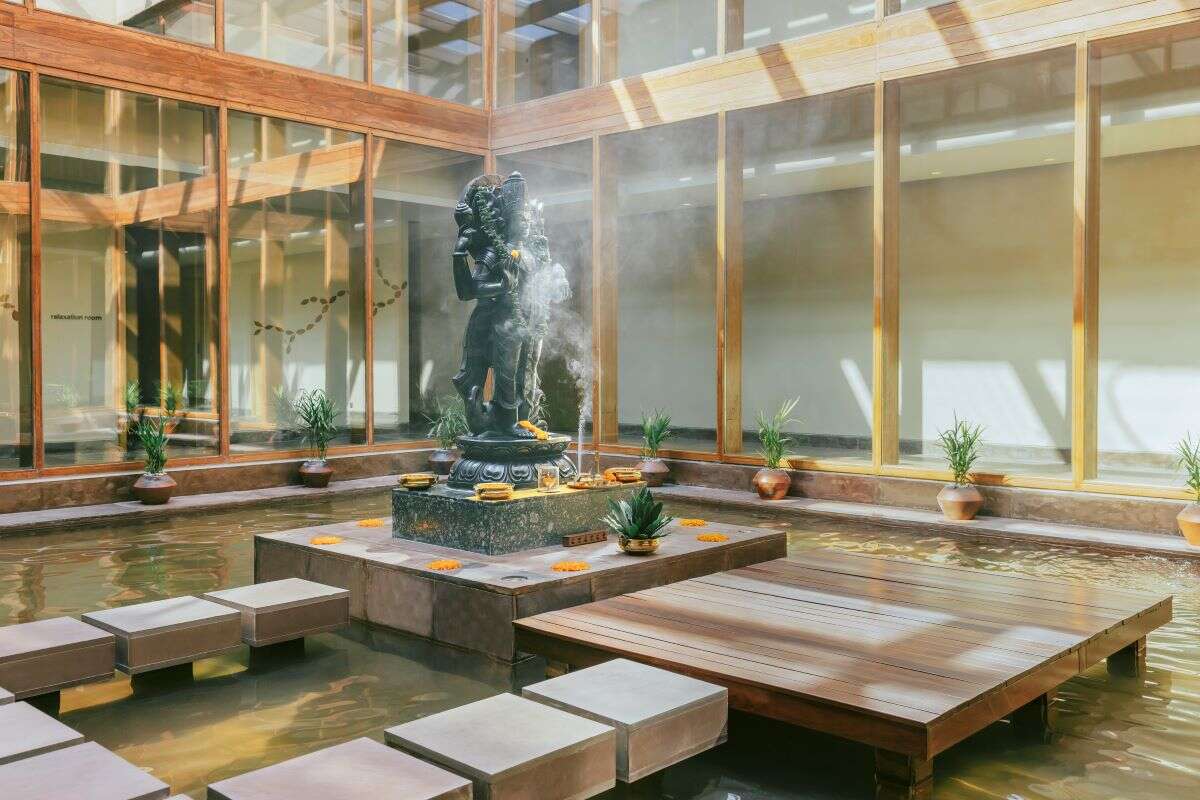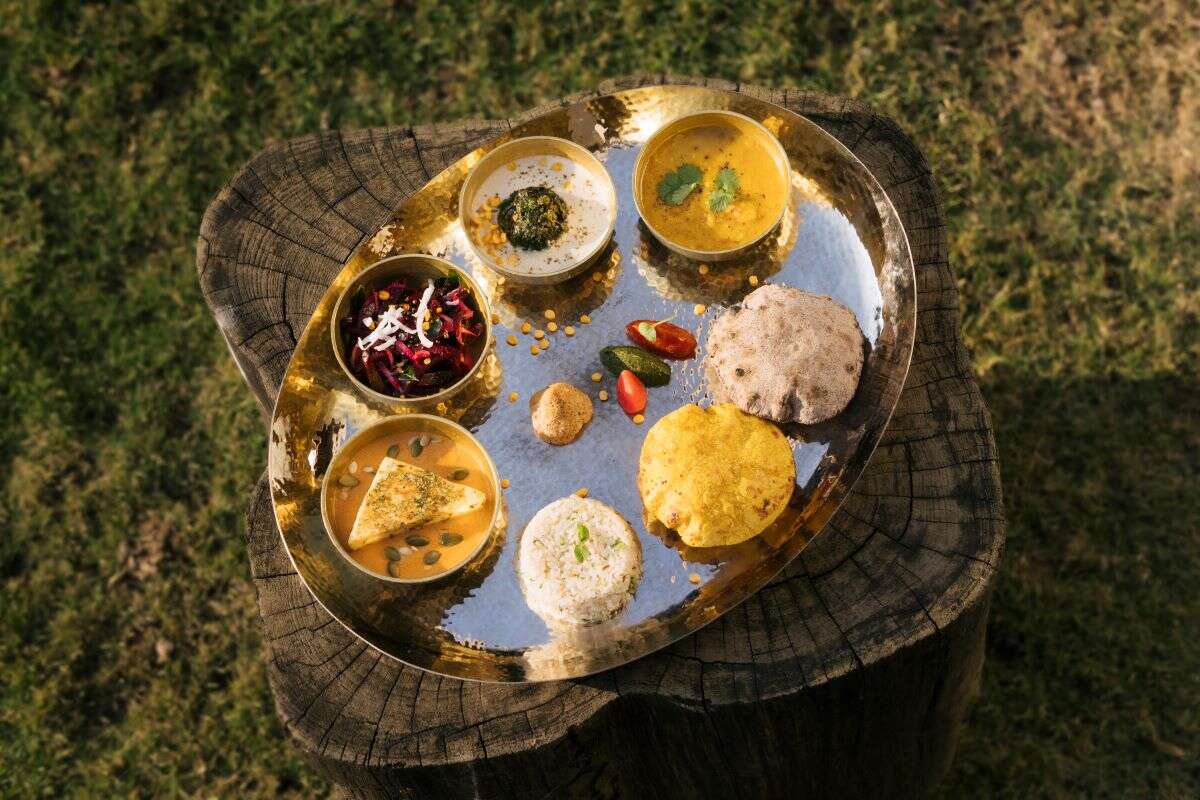
“Your body nature is bekan, but you have an imbalance of fire,” Dr Sopa, a specialist in Tibetan medicine, tells me after an extremely meticulous reading of both my left- and right-hand pulse. I am on day two of a five-day wellness journey at Six Senses Vana in northern India and seated in the doctor’s office, dressed in white organic kurta robes presented to me on arrival to wear throughout my stay. Dr Sopa is midway through my welcome consultation and is checking my bio-energy.
In Tibetan medicine, also referred to as Sowa Rigpa, there are three types of bio-energy — loong (air element), tripa (fire element) and bekan (earth and water elements). These form the characteristics of body, energy and mind. My pulse reading is backed up by a hi-tech wellness screening in which I’m hooked up to a number of pads as Dr Sopa takes a reading of 30 different biomarkers covering everything from my vascular age — good; serotonin levels — mediocre; and metabolism — somewhat lacking.
The fiery imbalance is stress-related, the doctor tells me. My time at Vana will be spent starting the process of rebalancing this with a mix of treatments, diet and select activities from the weekly retreat programming. Enveloped within a Sal forest on the edge of the city of Dehradun, Vana opened in 2014 as a sanctuary for rebalancing, healing and learning in India’s Himalayan foothills. A bastion of sustainability, the 21-acre, LEED platinum-certified retreat rapidly garnered a devoted following, establishing itself as a world-leading — and architecturally stunning — well-being institute.
[See also: The Best Wellness Retreats in the US]
 Vana opened in 2014 as a sanctuary for rebalancing, healing and learning in India’s Himalayan foothills / ©Six Senses
Vana opened in 2014 as a sanctuary for rebalancing, healing and learning in India’s Himalayan foothills / ©Six Senses Initially specializing in Ayurveda (a system of ancient Indian medicine), two years later Vana unveiled a state-of-the-art Sowa Rigpa center; it remains one of the few places in the world where Tibetan medicine is formally offered in its totality. In 2023 it was acquired by the pioneering wellness group Six Senses, becoming the eco-conscious hotel brand’s first dedicated wellness retreat. But bar a few hi-tech touches (like my biomarker screening), Six Senses has intentionally changed very little about Vana.
After my consultation with Dr Sopa, I head to the Sowa Rigpa center for a Mongolian-style Hor Gyi Metsa massage, passing pictures of the Dalai Lama on his visit to the facility shortly after it opened. Following centuries-old protocols, prior to treatments, therapists — who, like Dr Sopa, are graduates of the Dalai Lama’s revered Tibetan Medicine and Astrology Institute — prepare high-altitude herbs using ancient texts. The treatment is more intense than the Ku Nye massage I had at the center the night before, during which I’d almost levitated out of the treatment room. Today, forceful thumb pressure and warm pouches stuffed with medicinal plants are applied along my body’s loong points to balance my nervous system. Though uncomfortable at times, the treatment reaches deep into pain I never knew existed.
An intense massage I can handle, but it is my next treatment prescribed by Dr Sopa that I am most apprehensive about: acupuncture. But I needn’t have been. “I don’t call them needles; I call them feathers,” Dr Dimple, a specialist in traditional Chinese medicine, reassures me as I’m lying on her acupuncture table. Her warm demeanor puts me unusually at ease as she explains that the treatment aims to release emotional blockages throughout my body. Despite my current status of face-up pins protruding and having spent barely 24 hours at the retreat, I already feel an out-of-character level of relaxation.
[See also: Iconic Spas of the 21st Century]
 The fragrant Indian thalis / ©Six Senses Vana
The fragrant Indian thalis / ©Six Senses VanaAfterwards, I resist the urge to check my phone back in my room (electronic devices are banned in all public areas). Instead, I wrap myself in a blanket in the kila, a vast communal space centered around an enormous water feature that forms the heart of the retreat. In the corner on a raised platform, a musician strums traditional songs on a sitar ahead of dinner.
Thankfully, unlike some wellness retreats, dining at Vana is joyous. At lunch I dine on fragrant Indian thalis (platters) at Ayurvedic restaurant Anayu. The main restaurant, Salana, serves exquisitely plated three-course dinners that would not look out of place in a Michelin-starred restaurant.
Ever-changing seasonal menus are created using a rainbow array of organic ingredients sourced from the retreat’s own gardens and a local network of sustainable suppliers. Though the portions are low calorie and on the petite size, I’m never left hungry, as dishes such as delicate Malabar fish curry followed by pistachio and nougat parfait — topped with a sesame tuile — are as nourishing as they are pretty.
Sticking to the dietary restrictions set out by Dr Sopa is easy thanks to guidance on the menus, as well as the chef and his team keeping a close eye on guests’ nutritional requirements, which are supplied to the kitchen by the medical team. By my third day, I realize I have unintentionally weaned myself off my daily three-coffee minimum — replacing my addiction with a slew of aromatic medicinal teas (the cinnamon, turmeric and ginger becoming a fast favorite).
 Rooms and light-filled and calming / ©Six Senses
Rooms and light-filled and calming / ©Six Senses My sleep is better for it, for which I am grateful — as, considering I am on a wellness retreat, my schedule is surprisingly full. I take Dr Sopa’s advice and immerse myself in pratah yoga sessions. Slower-paced than my usual Vinyasa flow class back home, they enable me to mindfully focus on breathwork. Tibetan Gom meditation within the underground glow of the meditation cave is particularly good at helping me to switch off.
In between subsequent therapeutic sessions — including an hour of reflexology, in which the doctor is able to pinpoint my back pain with meticulous precision and I receive an aligning massage at the Ayurveda center — I manage to squeeze in a couple of excursions. The first is a vigorous early morning uphill hike to the picturesque Santala Devi temple — by far the most exercise I get over the five days and the only time that I am out of my white robes. Then there is a voyage to Rishikesh, the so-called yoga capital of the world. Here, I witness the Ganges Aarti, a mesmerizing choreographed fire offering performed on the banks of the sacred Ganges River.
On my final evening, I head for my last treatment, Watsu, a kind of water shiatsu (a non-invasive therapy that originated in Japan). I am somewhat skeptical of its benefits but also a tad reluctant, as it is said it can make you feel quite vulnerable. Like a baby in its mother’s womb, you are immersed in a pool heated to 94.1° Fahrenheit; advocates of the treatment compare it to being reborn. Despite my preconceptions, for 60 minutes I am swirled and stretched by a therapist in the warming waters, and it is like nothing I have experienced before. As the therapy progresses, all of my mental chatter begins to melt away and I experience a deeper connection to myself than I have felt for a long time. Perhaps this is what rebalancing feels like. Whatever it is, Vana has worked its magic.
From $570 per person for a three-night minimum stay. Contact reservations-vana@sixsenses.com, +91 135 351 1111, sixsenses.com
[See also: The Transformative Retreats That Are Redefining Wellness]

 German (DE)
German (DE)  English (US)
English (US)  Spanish (ES)
Spanish (ES)  French (FR)
French (FR)  Italian (IT)
Italian (IT)  Macedonian (MK)
Macedonian (MK) 







Comments